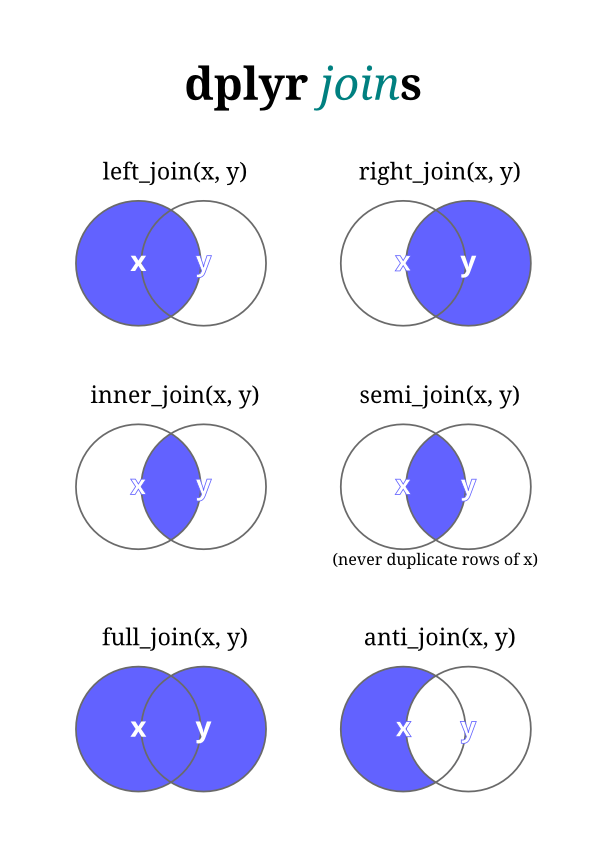-
Notifications
You must be signed in to change notification settings - Fork 9
/
Copy pathjoin.qmd
110 lines (75 loc) · 2.34 KB
/
join.qmd
1
2
3
4
5
6
7
8
9
10
11
12
13
14
15
16
17
18
19
20
21
22
23
24
25
26
27
28
29
30
31
32
33
34
35
36
37
38
39
40
41
42
43
44
45
46
47
48
49
50
51
52
53
54
55
56
57
58
59
60
61
62
63
64
65
66
67
68
69
70
71
72
73
74
75
76
77
78
79
80
81
82
83
84
85
86
87
88
89
90
91
92
93
94
95
96
97
98
99
100
101
102
103
104
105
106
107
108
109
110
---
title: "join two data frames"
author: "John Little"
date-modified: 'today'
date-format: long
format:
html:
footer: "CC BY 4.0 John R Little"
license: CC BY
---
```{r}
library(tidyverse)
```
## Join
There are a series of [join commands](https://dplyr.tidyverse.org/reference/index.html#section-two-table-verbs)
- left_join, inner_join, right_join, full_join,
- semi_join, anti_join

First let's read in the favorability ratings data from fivethirtyeight.com
## data
These exercisees use the following [`ggplot2` training datasets](https://ggplot2.tidyverse.org/reference/index.html#section-data)
- dplyr::starwars
- Data from fivethrityeight.org (modified)
```{r}
fav_ratings <- read_csv("data/538_favorability_popularity.csv", skip = 11)
fav_ratings
```
```{r}
starwars
```
Join on a **key** that is common across two data frames. For best results use a numeric key that promotes precision. Of course, we're going to use a alphabetic key, `name`, which will highlight what can go wrong and introduce troubleshooting strategies.
In this case, the key will be the `name` variable that is common to both tables. We're using the `fav_ratings` tibble and the `starwars` tibble.
```{r}
fav_ratings %>%
# left_join(starwars, by = "name") |>
# left_join(starwars, by = c("name" = "name"))
left_join(starwars) %>%
arrange(desc(fav_rating))
```
### anti_join
what is in the left table and not the right table.
```{r}
anti_join(fav_ratings, starwars) %>% arrange(name)
anti_join(starwars, fav_ratings) %>% arrange(name)
```
### semi_join or inner_join
join only the rows that match.
```{r}
fav_ratings |>
semi_join(starwars)
```
### Regex
Regular expressions and {stringr} can be handy when manipulating character variables into join keys.
- str_detect()
- str_to_lower()
- str_remove()
- str_trim()
- str_extract()
```{r}
starwars %>%
filter(str_detect(name,
regex("3p|palpatine|obi|amidala|leia|d2",
ignore_case = TRUE))) %>%
arrange(name)
```
```{r}
fav_ratings %>%
filter(str_detect(name,
regex("3p|palpatine|obi|amidala|leia|d2",
ignore_case = TRUE))) %>%
arrange(name)
```
## See Also
- dplyr::**bind_rows**()
- dplyr::**bind_cols**()